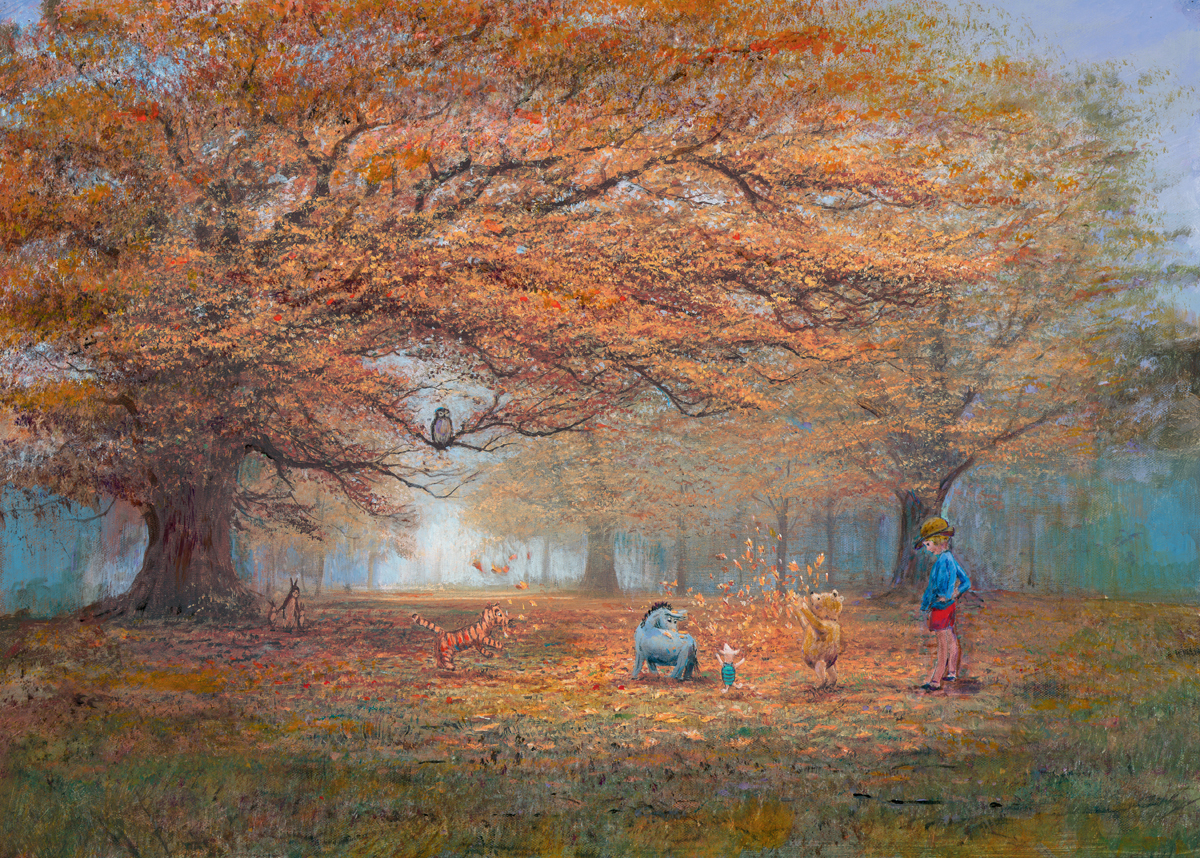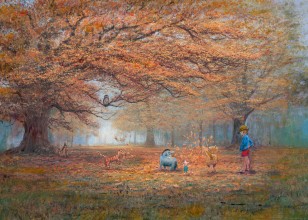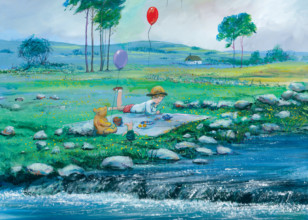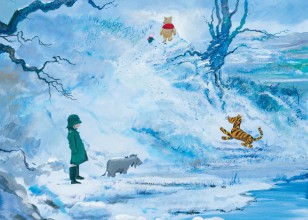Product Description
The Joy of Autumn Leaves Winnie the Pooh Embellished Giclee on Canvas by Peter and Harrison Ellenshaw is created by a father-and-son team of Disney legends.
About Peter Ellenshaw:
PETER ELLENSHAW (1913-2007), whose artistic career spanned more than seven decades, was considered the premier seascape and landscape artist of his generation. He worked with many acclaimed filmmakers including Walt Disney, Stanley Kubrick, Michael Powell and W. Percy Day. He was an Academy Award® winning special effects artist, a motion picture production designer, a concept illustrator and an official 'Disney Legend.'
Born in London, England in 1913, Ellenshaw was fortunate enough in his early twenties to get a job as an apprentice to W. Percy Day, O.B.E., the British film industry’s foremost special effects artist and matte painter. Matte shots are realistic paintings done on glass of extended sets or fantasy locations which are combined with scenes of actors in real sets. Day, the Royal Academy trained artist, took Peter Ellenshaw under his wing, working on such classics as Things to Come, The Thief of Baghdad and Black Narcissus.
After serving in the Second World War as a pilot for the Royal Air Force, Peter returned to the film industry as a matte artist for MGM's Quo Vadis. In the late 1940s Walt Disney approached Ellenshaw to work on the studio's first live action feature, Treasure Island. Thus began a professional collaboration and friendship which lasted over 30 years and 34 films.
In 1953, Peter and his family moved to California and Ellenshaw found himself expanding upon his matte painting work to contribute to the dramatic and spectacular special effects on Disney's epic film 20,000 Leagues Under the Sea. The Walt Disney Studio was also in the pre-planning stages for Disneyland. Ellenshaw contributed his artistic touch to many of the attractions at the new theme park, including the first Circlevision theater show, TWA's Rocket Ship to the Moon and X-1 Satellite View of America.
It was in the 50s that Peter fell in love with the ocean and would spend weekends painting the picturesque coves and crashing waves along the California coast. He developed a reputation as a fine art painter whose oils soon became highly sought after by collectors. He also began a lifelong association with the prestigious Hammer Galleries in New York.
In 1960 Ellenshaw did a matte painting of Rome for Stanley Kubrick's Spartacus, while continuing to work full time for Disney studios. Peter contributed to the popular television show 'Disneyland' with work on Davy Crockett and Zorro, as well as classic Disney features including Darby O'Gill and the Little People, Mary Poppins and The Love Bug. For Mary Poppins Peter won an Oscar® for Best Special Visual Effects on the landmark film. He has also been nominated for an Academy Award® an additional three times; for his production design work on Bedknobs and Broomsticks and The Island at the Top of the World as well as for his effects work on The Black Hole.
In 1970 Peter and his wife, Bobbie, moved to the Ring of Kerry in Ireland and it was there that Ellenshaw created some of his most spectacular artwork: paintings of the rugged Irish coast and the beautiful landscapes of the Emerald Isle. His works were shown at a special exhibition at the American Embassy in Dublin. Today a number of his paintings can be seen in collections throughout Ireland including Adare Manor, Dromoland Castle, Waterville House and Ashford Castle.
Continued travels took Ellenshaw to many spectacular locales where he expanded his subjects to include the Himalayas, Monet's garden at Giverny, the Mojave desert, San Francisco and New York cityscapes, America's Cup yachting, and famous golf courses throughout the world.
In 1993, Peter Ellenshaw was officially designated a 'Disney Legend' at the Walt Disney Studios in a ceremony presided over by CEO Michael Eisner and Roy E. Disney. It was shortly thereafter that he was commissioned to do paintings of scenes from famous Disney features, many of which have been made into the wonderful giclées that you see here at our website.
In February of 2007, Peter passed away peacefully at his home in Santa Barbara, California. He was 93 years of age.
HARRISON ELLENSHAW: Many sons growing up in the shadow of a famous father feel that they want to carve their own paths in life. That was me, says Harrison Ellenshaw, son of Disney Legend and master painter Peter Ellenshaw, who won an Oscar for his visual effects work on "Mary Poppins and was nominated a total of five times for the Academy Award. I had grown up fascinated by my father's painting." Harrison says. He would sometimes give me canvas and paints. I have photographs of me painting when I was a small boy. My father's life was painting, even during meals he would bring the canvases he was working on into the kitchen and sit and eat and look, criticizing his own work. My mother was not always pleased that this was how the family spent mealtime, but she understood his passion. But I found both this passion and his incredible talent intimidating. I was convinced I could never live up to any of it.
Harrison graduated from Whittier College with a BA in psychology. By then, in the early 70s, the country was in the throes of a recession and Harrison found it difficult to find a job. I remember driving with my father one day, he recalls, and he said, Well, you know, just for the time being, if you're interested, the matte department at Disney is looking for apprentices. The department head at that time was Alan Maley, who had worked as a matte artist with Harrison's father in years past. So I went and talked to Alan, and we agreed that we'd give it six months.
Alan became my mentor, Harrison says, and it was due to his enthusiasm and encouragement that I really got bitten by the film bug. It had been very unique growing up having a father who knew and worked for Walt Disney -- he was a living legend, an icon. But in a sense I took being in a 'show business family' for granted. It was Alan who showed me what was so special about film -- about matte paintings; how your work on shots could be an integral part of telling a story." After about four years, Alan Maley retired. "He told me I could take over as department head," Harrison remembers. It usually takes twelve years as a journeyman to become a department head. The studio was a little hesitant and I was scared to death. Maley offered to return to give Harrison a hand if necessary, so he took the job.
Then, Harrison got a phenomenal break. Fate smiled on me, as it had for my father, he says humbly. I got a chance to do some work on Star Wars. At this point, a tale of two Ellenshaws becomes the tale of two separate Ellenshaws, as this is where Harrison begins to really strike out on his own, away from his father's legacy. His work on Star Wars was so well received that he was asked to return to work on The Empire Strikes Back. By this time, having clearly carved a niche for himself, Harrison had no problem working with his father on Disney's The Black Hole in 1979. Harrison then went solo again to add his unforgettable touch to Tron, one of the most unique and visually stunning films ever, now a cult classic.
After work on "Captain Eo," "Superman IV," "Ghost" and other films, a memorable year for Harrison was 1989, when he worked on Dick Tracy. The matte paintings were visually the star of that film, he recalls. And by then I was doing some fine art painting on my own. But it was around that time when I was working on this incredibly colorful film that an exhibition of Fauve artists came to the Los Angeles County Museum of Art. Fauve, which in French means wild beasts, was a name given to a group of up and coming rebel French artists in the 1900s, who included among their ranks Henri Matisse and Andre Derain. The Fauve painters took a traditional art form and began using forms and colors which were not found in nature, painting familiar objects with startlingly wrong colors, in an attempt to liberate color.
Up until this point I had been painting trees with black, gray and brown trunks and green leaves, he points out. And then I came across the Fauves, who were only in existence a few years, and their intense use of color. They had done something I really enjoyed and appreciated. So I began to paint far more colorfully than I had in the past. Today, I enjoy painting as much as ever and I enjoy doing things that are really colorful. The great thing is that now with the giclée process of making prints, you can match the colors perfectly. Harrison's work has been exhibited at the prestigious Hammer Galleries in New York, as well as galleries in London and San Francisco.





